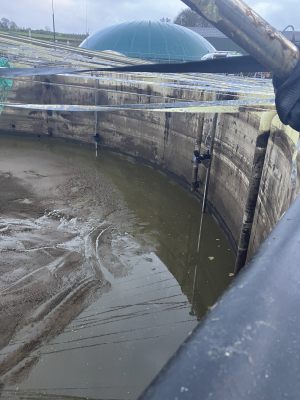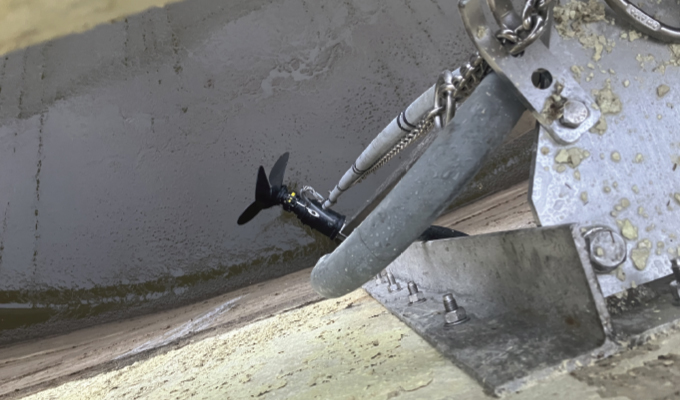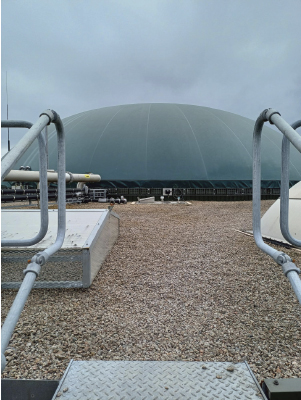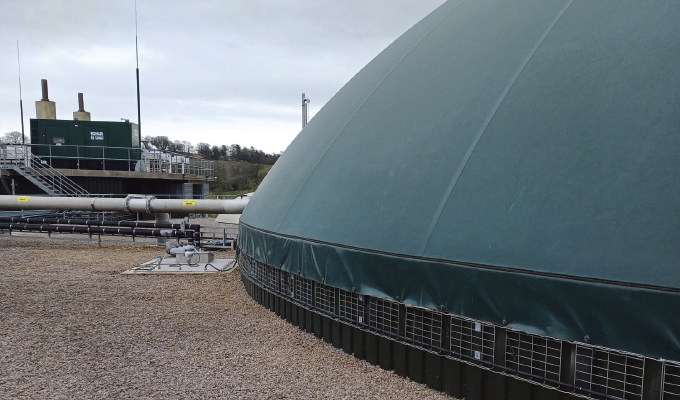New to the AD/biogas industry, Ross Mingotti could have been forgiven for walking away from a plant that had already had major mixing issues in its final storage tank. Within two months of him joining the business in December 2021, one of the paddle mixers in the secondary tank failed.

The mixers had worked well since being commissioned in 2017 at Ampgreen Estates’ Greengill Farm AD plant (near Penrith, Cumbria, in the far north of England), but now came the problem of retrieving them. This wasn’t possible without emptying the tank; in this case from the final storage tank, which holds close to three million gallons of digestate.
“The final storage tank had already been offline for twelve months,” says Mingotti. “But at least we were still able to run our primary digester, which is the outer ring of the site’s tank-within-a-tank design.”
Jamie Seggie, appointed as AD plant manager in February 2022, must have also wondered what he’d walked in to—and then to make matters even worse, the invasion of Ukraine shortly afterwards created a delay in the replacement mixers that had been ordered. As a 2.4MwH plant, supplying power to the grid was a considerable problem in downtime and loss of income.
“After a three-month wait, with still no word on the delivery of new parts,” adds Mingotti, we decided to look elsewhere. Our final storage tank had become very crusted over, but we managed to get it moving temporarily with a very basic propeller mixer that we could mount on the back of a tractor. We went to ADBA’s World Biogas Expo in Birmingham, where we looked hard at some new mixing systems to see what might suit us.
“Potential suppliers then came to visit, and could immediately see that this was a site in distress, but while price always comes into it, Jamie and I knew we needed to feel comfortable with whom we were going to work with, and not be taken advantage of with all sorts of add-on sales. We may have been new to the AD industry, but we were learning fast. It was clear that there hadn’t been much focus on preventative maintenance, but then the original design, with these paddle mixers trapped inside the tanks, made servicing, repair or replacement very time-consuming and costly. Nobody in the business wants to empty the tank. You can’t just then switch it back on and be back to where the plant should be. It takes around twenty to forty days, and even then, the gas isn’t at its best quality.”
“We soon saw large increases in hydrogen sulphide, and unwanted spikes in gas quality, so you’re then having to focus less on the actual digesters and more on protecting the engines,” adds Seggie. “There’s also the knock-on effects of having to do more oil changes. Parts were wearing much quicker on downstream equipment. With a thermophilic system, there are also significant fuel and boiler costs in heating the tank to bring it up to and keep it above 50 degrees Celsius.”

THE NEED FOR A RELIABLE MIXING SYSTEM
“Ross and I knew that moving forward, we needed a reliable mixing system that could be looked after, without such major disruption to the process, and a company that would support us,” says Seggie. “The challenge facing us and our new supplier was the sheer size and volume of our final storage tank (with tanks partially buried underground), and how to get it mixing properly.”
After very careful consideration, Mingotti and Seggie went ahead with mixers from Landia.
“We knew Landia had a proven track record, and importantly, that they had people on the ground and spare parts readily available in the U.K., so we could get the local support that we needed. It was clear from the outset that they were totally committed to what we were trying to achieve, and importantly for us, everything was flexible,” continues Seggie. “They were open, honest, and listened; not trying to sell themselves as process engineers, but wanting everything to work, understanding that everything is connected; unlike some that just want to come in and say ‘yes, that’s the one bit that we’re responsible for,’ and not seem to care about whether they’ve actually delivered a solution. Likewise, we weren’t oversold to. For example, with the electrics—Landia said they could do it, but that it wasn’t their bread and butter, so if we had a trusted local supplier, then that would be fine.”

CREATE SEVERAL MIXING PATTERNS WITHIN THE TANK
“Again, some suppliers might have tried to sell us as many mixers as possible, but starting with our inner annulus tank (our second digester), Paul Broadhurst at Landia came back with a design of four 22kW submersible mixers,” notes Seggie. “And slightly later, for our final storage tank, a total of six mixers (four 11kW, two 22kW), positioned at different heights and running at different speeds and times to create several mixing patterns within the tank, to achieve the desired effect. Now, with the Landia mixers, both of these tanks get mixed properly, but with minimal power consumption.”
From the Penrith site’s 2,500 acres, maize, grass silage, and sometimes rye or wheat are utilized as feedstock, feeding in at around 104 tons per day, with approximately 8 percent total solids for the second digester and around 5 percent total solids for the final storage tank, from which most of the gas is pulled to run the CHP engines. In Mingotti and Seggie’s steep learning curve, they’ve understood that while a higher dry solids content means more gas, it can also lead to a point when the tank can’t be mixed. And to further help the consistency of the tank’s contents, AmpGreen is now ensuring that across the estate, all crops/feedstock are chopped to no more than 5mm, so that everything breaks down properly in the AD process. After using around 15 percent of the power generated for its own needs at the AD plant, an impressive 85 percent is sent straight to grid.

ALWAYS PREPARED TO HELP
Mingotti adds, “About six months after we’d tried to order the parts from our original supplier, we were finally told that they were ready—but of course, out of necessity, we’d long since moved on—to a key position now that with preventative maintenance and known factors, we can control our costs. We now have a maintenance contract with Landia for them to service the mixers every six months. Once again, they didn’t pressure us to take this on or insist it was part of some inflexible deal. They offered to work with and train our own maintenance people, but I have to say that the Landia guys who come here are fantastic. They obviously tafke a lot of pride in what they do, and want their customers to be happy.
“We can’t deny that during the switchover to the new mixers, it has been fairly complicated and stressful at times, but the Landia install team really shone. Things have a habit of changing during a project, but Paul Broadhurst (Landia) and ourselves were always in contact, working together to find the very best solutions, living with the job as it developed—and we still have the peace of mind now, knowing that they care, and will always be prepared to help.”
Soren Rasmussen is the director of Landia, Inc. Landia uses its nearly ninety years of experience to continue to develop new and efficient products and solutions. Together with its customers, Landia is aiming for new heights. Customers get a partner with a strong team of happy employees who focus on what matters most to them: good solutions that solve the task at the lowest possible cost. For more information, call 919.466.0603, email info@landiainc.com, visit www.landiainc.com.


